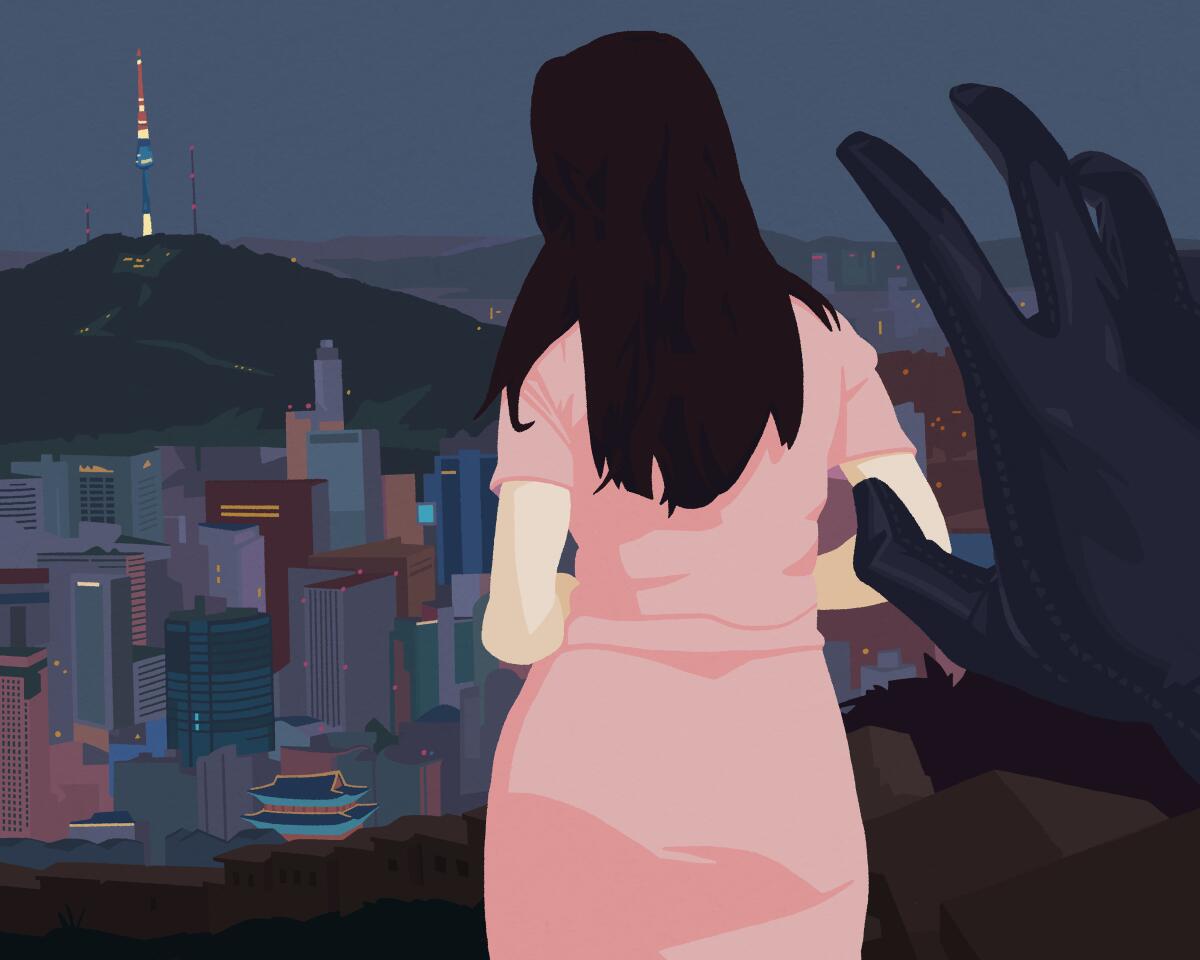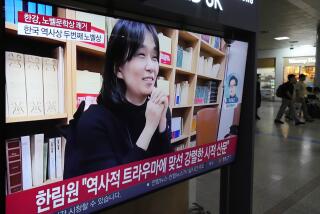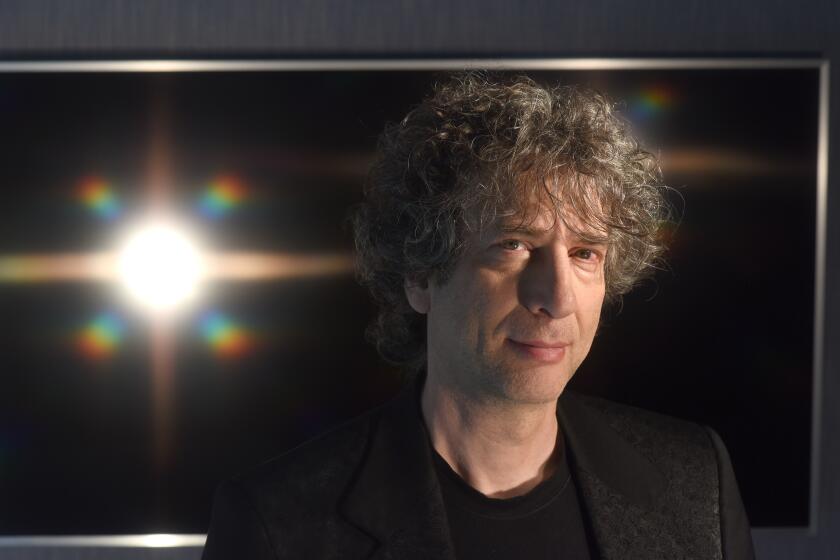Review: ‘The Only Child’ arrives as Korean thrillers come of age

- Share via
Whether it’s English village life or contemporary Olso, imported crime fiction has long given readers a peek at the underbelly of cultures outside their own. And yet Korean crime fiction, which has existed for at least 100 years, woefully trails the critical acclaim of Korean cinema that culminated in this week’s Oscar for “Parasite.” The genre is just beginning to show signs of crossover success in the U.S. but still lags far behind the reader-friendly “Nordic noir,” or “Tartan noir,” that’s been in fashion for a while now. It doesn’t help that our perspective has been, until lately, refracted primarily through the lens of ostensibly knowledgeable non-Koreans like former intelligence officer James Church, author of the Inspector O series, or Martin Limón, whose U.S. military service informs several of his 1970s-era Sueño and Bascom mysteries.
For me, the first harbinger of Korean lit as a global phenomenon was Kyung-Sook Shin’s “Please Look after Mom,” a bestselling South Korean literary novel about a long-suffering rural woman’s disappearance and her selfish family. It was awarded the 2011 Man Asian Literary Prize, despite being panned by one American critic as “kimchee-scented Kleenex fiction.” Five years later, Han Kang won the Man Booker International Prize for “The Vegetarian.” And after a few fits and starts over the past decade, the publication of “The Good Son” in 2018 and “The Plotters” a year later gave Korean mysteries in particular a well-deserved boost.
Joining that small but growing body of work is Mi-Ae Seo’s newly translated novel, “The Only Child,” which exposes American audiences to the ties that bind and break two very different Seoul families.
Although this is Seo’s English-language debut, “The Only Child” isn’t her first published work; in Korea, she’s an accomplished screenwriter, novelist and recipient of a national prize for detective literature. The novel’s protagonist, forensic psychologist Seonkyeong, is given the opportunity to interview a notorious serial killer, Yi Byeongdo, who has requested the meeting. But Seonkyeong herself is a bit of an impostor, having leveraged a brief FBI training course she took while studying at an American university into a post teaching criminal psychology in Seoul. “By the time Seonkyeong became familiar enough with the vast FBI Academy to find the bathroom without getting lost,” Seo writes, “the training was over.”
Seonkyeong’s lack of experience doesn’t prevent her from lecturing students on popular American theories of abnormal psychology, including the widely promulgated triad of behaviors predictive of sociopathy or even serial killing — persistent bed-wetting, arson and animal cruelty. But her students want to know: Is it nature or nurture? Seonkyeong, whom the students dub Clarice Starling after Hannibal Lecter’s frenemy in “The Silence of the Lambs,” doesn’t yet have the experience to provide an authoritative answer, although she, and the reader, are about to get a close-up look at both sides of the argument.
The nurture hypothesis is bolstered by Yi Byeongdo, self-confessed kidnapper and murderer of at least 13 women in and around Seoul. Seo plumbs the mind of the attractive killer, known by detectives as “the devil disguised as an angel,” in fascinating chapters that alternate with those that follow Seonkyeong, her family and investigators. We learn that, from the time he was 3 or 4, Yi Byeongdo’s vicious mother had, on various occasions, tried to drown him, stabbed him with scissors, broken his bones and bitten off his flesh, all while singing the murderous, sprightly Beatles tune “Maxwell’s Silver Hammer.”
The child endured this torture for almost eight years until he escaped by stowing away in a trucker’s cab. After a tragic accident en route to the countryside, he was adopted by the trucker’s widow, a caring apple farmer and mother of three daughters. Honest labor and a loving family provided a respite from the violence before he returned to Seoul at age 14 to confront his mother and embark on a darker path.
Having just touched on the mass killer’s mother and that deadly song before Yi Byeongdo abruptly ends the interview, Seonkyeong comes home to discover that her new husband, a physician, has brought home his 11-year-old daughter, Hayeong, to live with them. (Oddly, stepmother and stepdaughter have never met.) Early scenes establish how broken Hayeong’s family is — her parents divorced bitterly before her mother took her own life, then a fire killed her maternal grandparents, who had assumed custody of the girl. But the slow reveal of who Hayeong really is becomes creepier, in many ways, than Yi Byeongdo’s story and showcases not only the power of nature over nurture but also Seo’s exquisite ability to build suspense.
“The Only Child” owes much to Thomas Harris’ groundbreaking “Silence of the Lambs,” from the first question Yi Byeongdo asks Seonkyeong (“What’s the oldest memory in your head?”) to the protagonist’s loss of a mother at an early age. But whereas the FBI trainee develops into a competent agent, Seonkyeong is the weakest link among the three main characters in “The Only Child.” She is eventually able to exert control in her interviews with Yi Byeongdo but is incapable of doing the same in her relationship with Hayeong; every interaction with the girl exudes a messy mixture of protectiveness, frustration and that bane of the professional woman’s existence: guilt. “She had shattered the soul that had barely been kept intact,” Seo writes. “Would such a thing have happened if Seonkyeong had been an ordinary housewife?”
For all its strengths, “The Only Child” might lose something in translation — especially as it relates to Korean serial killers. Although Seo compares the angel-faced killer to the similarly good-looking Ted Bundy, it would have enriched my understanding to have more context on how the notorious Korean murderers she names have impacted the Korean culture, something Seo knows well from an article she wrote for a popular Korean newsmagazine. There is also occasionally a clumsiness in the language that I don’t know whether to ascribe to the translation (by Yewon Jung) or Seo’s style. Either way, this promising author deserves better from her editors on either side of the Pacific.
A chilling, nuanced examination of today’s and tomorrow’s serial killers and the families who spawned them, “The Only Child” is nevertheless a valuable addition to the growing list of Korean crime fiction available to American audiences. Soon, there may be enough critical mass to earn Korean crime fiction some catchy marketing sobriquet. K-crime might suit me fine, but it’s up to these talented creators to proclaim themselves, thereby claiming their place in the universe of international crime. But in the meantime, for God’s sake, don’t call it “kimchee” noir.
By Mi-Ae Seo, translated by Yewon Jung
Ecco: 293 pages; $26.99
More to Read
Sign up for our Book Club newsletter
Get the latest news, events and more from the Los Angeles Times Book Club, and help us get L.A. reading and talking.
You may occasionally receive promotional content from the Los Angeles Times.








